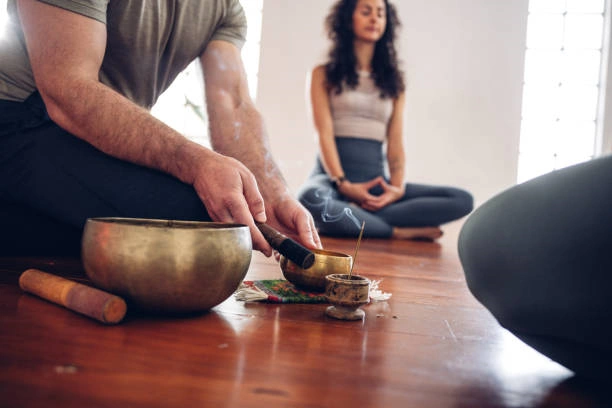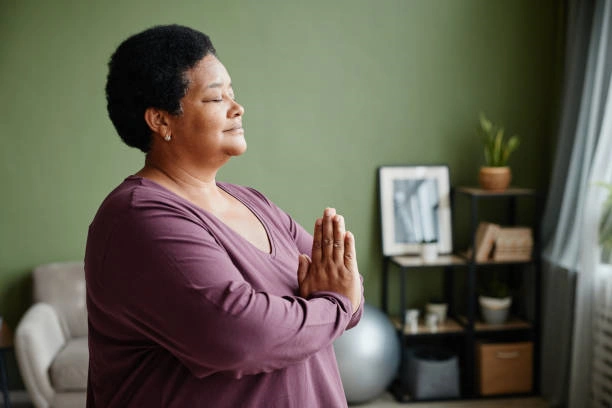Ten Classic Meditation Practices
1.Non-Doing
You can try this practice right now. Simply sit where you are without needing to sit cross-legged or go to a specific place. Gently close your eyes and sit quietly for one or two minutes. If many thoughts come up, just let them arise and pass naturally. Simply experience the feeling of sitting still without doing anything.
2.Body Awareness
This brief practice can be done anytime. Like the previous exercise, there’s no need to sit somewhere special; just stay where you are. Close your eyes and slowly focus on your body’s sensations. No matter what you were doing or discussing a moment ago, now bring your attention to how your body feels. It could be the feeling of your body pressing against the chair, your feet on the floor, or your hand holding your phone. Focusing on these tactile sensations can help because they are clear and perceivable. Even if your mind is chaotic, you can easily bring your attention back to your bodily sensations when you notice you’re distracted.
3.Thought Awareness
Here, we practice labeling our thoughts. If you’re recalling the past, silently say to yourself, “past, past, past.” If you’re planning for the future, say “planning, planning, planning.” If you hear a sound, label it as “sound, sound, sound.” If you’re feeling annoyed, say “annoyed, annoyed, annoyed.” By labeling your thoughts, you maintain awareness of them, acknowledging their presence without getting entangled in them. This awareness helps you become more calm and clear.

4.Emotional Awareness
We often struggle to identify our emotions because we get distracted by what we are doing or thinking. When you meditate, you will inevitably become more aware of your feelings—their type, intensity, and duration. What are you feeling right now? Take a few minutes, close your eyes, and start by noticing the sensations in your body. Do you feel heavy or light? Is there calmness or restlessness? Curiously explore each question for 20-30 seconds. Observe your breathing—whether it’s fast or slow, deep or shallow—without trying to change it. By the end of the practice, you may better understand your emotions.
5.Full Body Scan
To cultivate a healthy curiosity, apply it to your body sensations. Close your eyes and scan your body from head to toe multiple times. Start with a quick scan in about 10 seconds, then a slower one in 20 seconds, and finally take 30-40 seconds. Notice which parts feel relaxed, comfortable, or constrained. Try not to judge; simply understand how each part of your body feels. If your mind wanders, gently bring your attention back to where you left off.
6.Breath Meditation
This is a classic meditation practice. Choose a comfortable sitting posture. In an office, you can sit with your legs down on a chair. Relax your lower body, stretch your back naturally, open your chest, and relax your shoulders. Rest your hands on your knees with your palms up or clasp them together. Relax your neck and face, close your eyes, or keep them open if you’re feeling drowsy. Check your body for any remaining tension and relax those areas. Letting go is a key point in this practice.

7.Pre-Meal Meditation
Sit down with a straight back and relaxed shoulders before eating. Take a moment to relax your body and allow your breathing to flow smoothly. If you notice any tension or impatience, breathe into those areas to gradually soften them. Express gratitude for the food and those who prepared it, connecting with the food’s energy to nourish your body and mind. In Tibetan traditions, a chant is recited before meals. Throughout the meal, maintain silence and mindfulness, appreciating each bite and enhancing digestion.
8.Bathing Meditation
Anyone can practice this, and it’s convenient to do during daily bathing. Shed your clothes and worries, adjusting the water to a comfortable temperature. As you stand under the shower, imagine the water as pure energy cleansing your body from head to toe. Allow all stress, fatigue, and negativity to be washed away. Stay for a few minutes or longer until your body and mind feel completely relaxed. After drying off, stand still for a moment and appreciate the sense of well-being.
9.Walking Meditation
Start by standing with your feet shoulder-width apart and relax your body. Focus on your breathing, feeling its rhythm and flow. Gradually move your attention to your feet, noticing the sensation of your body’s weight resting on them. Shift your weight from one foot to the other slowly. After a few minutes, sense the connection between your feet and the earth, feeling grounded and present.

10.Smile Meditation
Make smiling a habit by practicing it every 15 minutes for a set time, whether three days, a week, or longer. You’ll likely forget to smile sometimes, and that’s okay. Each time you become aware, simply smile again. Observe how your body and inner state feel when you smile. You might notice tension in your face or a quickened heartbeat. This practice helps you discover many things about yourself and fosters clarity, ease, and joy.
Start now—smile, become aware, and begin practicing!




